Chinese Journal of Tissue Engineering Research ›› 2024, Vol. 28 ›› Issue (7): 1007-1014.doi: 10.12307/2024.101
Previous Articles Next Articles
Efficient strategies for microglia replacement in spinal cord injury models
Zeng Fanzhuo1, Li Yuxin2, Sun Jiachen3, Gu Xinyang2, Wen Shan1, Tian He4, Mei Xifan1
- 1Department of Orthopedics, Third Affiliated Hospital of Jinzhou Medical University, Jinzhou 121000, Liaoning Province, China; 2State Key Laboratory of Medical Neurobiology, Institute of Brain Science Transformation, Fudan University, Shanghai 200032, China; 3First Affiliated Hospital of Jinzhou Medical University, Jinzhou 121000, Liaoning Province, China; 4Liaoning Medical Testing and Drug R&D Collaborative Innovation Center, Jinzhou 121000, Liaoning Province, China
-
Received:2022-12-15Accepted:2023-02-18Online:2024-03-08Published:2023-07-15 -
Contact:Mei Xifan, MD, Professor, Department of Orthopedics, Third Affiliated Hospital of Jinzhou Medical University, Jinzhou 121000, Liaoning Province, China -
About author:Zeng Fanzhuo, Master candidate, Department of Orthopedics, Third Affiliated Hospital of Jinzhou Medical University, Jinzhou 121000, Liaoning Province, China -
Supported by:National Natural Science Foundation of China, No. 82072165, 82272256 (to MXF)
CLC Number:
Cite this article
Zeng Fanzhuo, Li Yuxin, Sun Jiachen, Gu Xinyang, Wen Shan, Tian He, Mei Xifan. Efficient strategies for microglia replacement in spinal cord injury models[J]. Chinese Journal of Tissue Engineering Research, 2024, 28(7): 1007-1014.
share this article
Add to citation manager EndNote|Reference Manager|ProCite|BibTeX|RefWorks
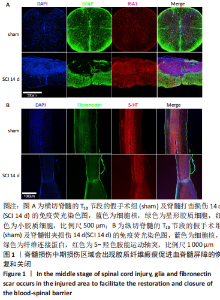
2.1 实验动物数量分析 实验选用小鼠共64只。①假手术组8只C57BL/6J野生型小鼠术后恢复及存活良好;②脊髓打击损伤组8只C57BL/6J野生型小鼠术后恢复及存活良好;③脊髓钳夹损伤组8只C57BL/6J野生型小鼠术后恢复及存活良好;④连体共生脊髓打击损伤组8对(8只β-actin GFP小鼠与8只C57BL/6J野生型小鼠分别一对一连体共生)小鼠消瘦感染死亡2对,剩余6对小鼠术后恢复及存活良好;⑤Mr BMT-X Ray组8只C57BL/6J野生型小鼠在他莫昔芬灌胃时意外死亡1只,剩余7只术后恢复及存活良好;⑥Mr BMT-Busulfan组8只C57BL/6J野生型小鼠术后恢复及存活良好。CX3CR1 creER-/+::LSL-BDNF-/+-tdTomato小鼠4只作为骨髓移植供体,CX3CR1 +/GFP小鼠4只作为骨髓移植供体。 2.2 脊髓损伤中期损伤区域会出现胶质纤维瘢痕促进血脊髓屏障的恢复和关闭 脊髓损伤后的早期(如1-7 d),由于血管破裂和星形胶质细胞死亡会导质血脊髓屏障的破坏和开放[21-22], 而在脊髓损伤的中期和晚期,随着星形胶质细胞增殖形成胶质细胞瘢痕和成纤维细胞增殖形成纤维瘢痕会促进血脊髓屏障的恢复和关闭,见图1A,B,一方面可以避免外周细胞向损伤部位的浸润和破坏,但另一方面会影响治疗药物和治疗细胞跨越血脊髓屏障进入脊髓实质发挥治疗作用。在脊髓损伤后的第14天,打击处脊髓损伤部位会有大量细胞坏死,组织形态发生病变,有大量的小胶质细胞或巨噬细胞增殖,并有大量的星形胶质细胞增殖形成胶质细胞瘢痕,而增殖的星形胶质细胞和纤维瘢痕则会关闭血脊髓屏障,从而可能影响传统的血液移植间充质干细胞的治疗效果,导致细胞不能在脊髓损伤后中晚期进入损伤区域发挥治疗效果。在脊髓钳夹损伤模型的第14天,脊髓损伤处有纤维瘢痕产生,并有大量的5-HT阳性的轴突断裂,而纤维瘢痕则会阻断5-HT阳性的轴突通过损伤部位。"
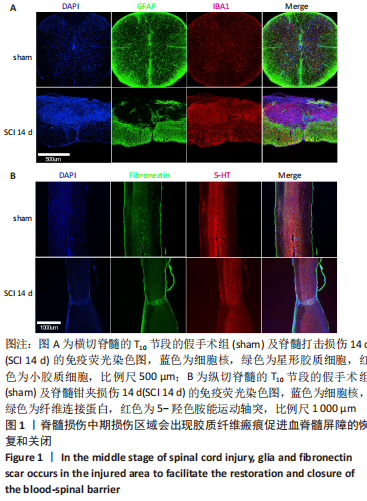
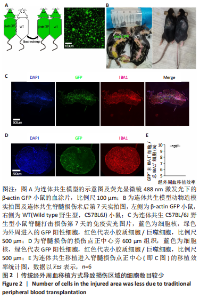
2.3 传统经外周血移植方式导致损伤区域的细胞数目较少 在既往研究中,骨髓间充质干细胞移植治疗脊髓损伤多通过静脉直接注射[5,9,23],或材料搭载间充质干细胞,而这种治疗方式受到血脊髓屏障等因素影响进入损伤区域的细胞比例和存活效率。为了验证传统的经血液循环移植细胞方式的移植替换效率,该实验采用了连体共生模型,连体共生是一种可以实现外周血液相互高效替换的技术,通过手术将2只小鼠缝合在一起后可以使2只小鼠的毛细血管连通并且有血液循环交互,在连体共生后的第14天,2只小鼠的血液可以实现约50%的交换[19]。多用于研究外周细胞与中枢的交互和迁移,以及用于病理或生理状况下细胞谱系分化研究[24-26],目前也有很多使用连体共生技术研究年轻小鼠血液对衰老小鼠的影响或研究年轻小鼠血液对阿尔茨海默症的表征和生理改变[27-28]。具体来说,将1只β-actin-GFP小鼠与1只C57BL/6J野生型小鼠缝合在一起,在连体共生后的第14天,分别将2只小鼠进行脊髓打击损伤造模。为了减轻连体共生小鼠的痛苦及提高连体共生小鼠的存活率,在脊髓损伤造模的第7天进行灌流取材。在脊髓损伤的中心部位,GFP阳性与IBA1(小胶质细胞/巨噬细胞标记物)阳性细胞占总IBA1阳性细胞比例大约为9.8%,而在脊髓损伤的损伤中心旁组织中GFP阳性细胞比例则更低,说明在脊髓损伤中晚期随着血脊髓屏障的关闭,能够进入到损伤区域的细胞比例可能更低,见图2。"
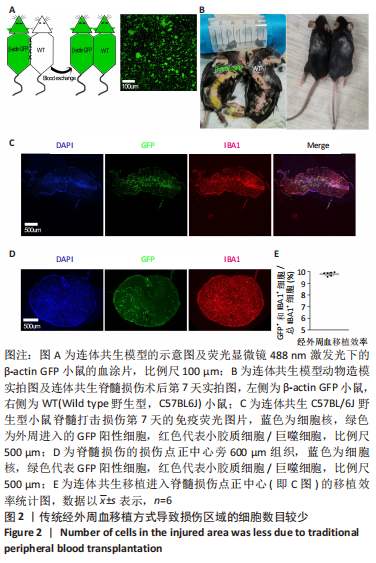
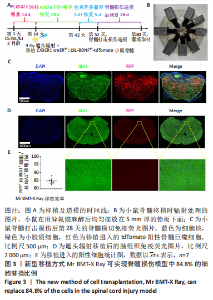
2.4 新型移植方式Mr BMT-X Ray可实现脊髓损伤后84.8%的细胞替换比例 BDNF作为经典的神经营养因子,在脊髓损伤中的研究较多,有研究表明BDNF可以促进脊髓损伤的恢复[29],并可以调控小胶质细胞和巨噬细胞向抗炎表型转变[30],而抗炎型的巨噬细胞则有利于脊髓损伤的恢复[31-33]。那么移植过表达BDNF的骨髓细胞对于脊髓损伤小鼠可能有较好的治疗效果,该实验使用CX3CR1 creER-/+::LSL-BDNF-/+-tdTomato小鼠,在给予他莫昔芬后,可以条件性地在小胶质细胞和巨噬细胞中过表达BDNF,并可以给小胶质细胞和巨噬细胞带上红色荧光蛋白示踪,以方便了解移植替换的细胞比例。复旦大学彭勃教授等开发的新型细胞移植替换方式可以实现中枢神经系统90%以上的替换效率并已经得到了应用[34],但非治疗区域细胞进入到脑与视网膜等区域可能是有害的,该实验完善改进了移植替换方式,在使用小胶质细胞CSF1R抑制剂PLX566清除脊髓小胶质细胞14 d后,在用9 Gy的X射线清髓移植时用铅板遮盖小鼠的头部以阻止辐射打开血脑屏障从而使移植的细胞只进入脊髓而不进入脑组织中。实验证明这种方式可以实现大约84.8%的脊髓小胶质细胞移植替换效率,并不会导致细胞进入到脑组织中,见图3。"
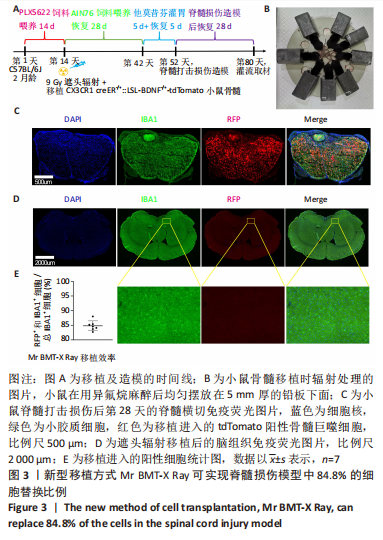
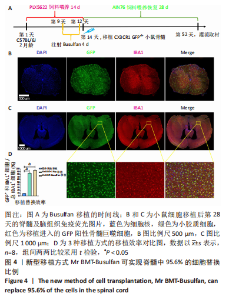
2.5 新型移植方式Mr BMT-Busulfan可实现脊髓中95.6%的细胞替换比例 辐射移植方式有一个不可忽略的问题就是,致死性辐射在打开血脊髓让移植的细胞进入到脊髓的同时可能也会对脊髓中的神经细胞或神经干细胞造成损伤[35-36]。于是该实验根据彭勃教授等开发的细胞替换方式进行了改善,在使用小胶质细胞CSF1R抑制剂PLX566清除脊髓小胶质细胞14 d后,使用化疗药白消安去清除受体小鼠的骨髓并打开血脊髓屏障以方便移植的细胞进入到中枢神经系统。由于实验时新冠疫情影响导致无法获得CX3CR1 creER-/+::LSL-BDNF-/+-tdTomato小鼠作为移植的供体,该研究使用可获取的CX3CR1 +/GFP杂合小鼠作为骨髓移植的供体。实验证明Mr BMT-Busulfan的移植方式可以实现高达95.6%的移植效率,远高于传统的经过外周血注射细胞的移植方式。但这种移植方式会导致不仅能替换脊髓的小胶质细胞,也会替换大脑中的小胶质细胞,见图4。 "
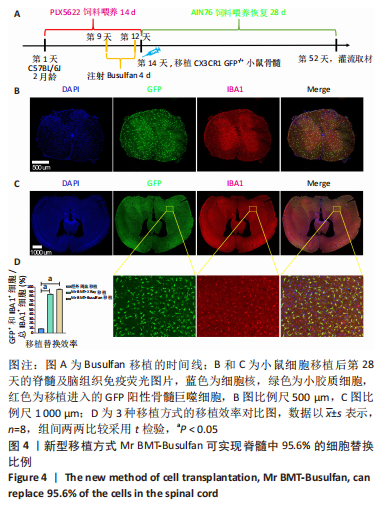
| [1] LEE BB, CRIPPS RA, FITZHARRIS M, et al. The global map for traumatic spinal cord injury epidemiology: update 2011, global incidence rate. Spinal Cord. 2014;52(2):110-116. [2] KWON BK, TETZLAFF W, GRAUER JN, et al. Pathophysiology and pharmacologic treatment of acute spinal cord injury. Spine J. 2004;4(4): 451-464. [3] KIYOTAKE EA, MARTIN MD, DETAMORE MS. Regenerative rehabilitation with conductive biomaterials for spinal cord injury. Acta Biomater. 2022;139: 43-64. [4] XIANG L, CHEN Y. Stem cell transplantation for treating spinal cord injury: A literature comparison between studies of stem cells obtained from various sources. Neural Regen Res. 2012;7(16):1256-1263. [5] RAMALHO BDS, ALMEIDA FM, SALES CM, et al. Injection of bone marrow mesenchymal stem cells by intravenous or intraperitoneal routes is a viable alternative to spinal cord injury treatment in mice. Neural Regen Res. 2018; 13(6):1046-1053. [6] ZHANG SX, HUANG F, GATES M, et al. Role of endogenous Schwann cells in tissue repair after spinal cord injury. Neural Regen Res. 2013;8(2):177-185. [7] ASSINCK P, DUNCAN GJ, HILTON BJ, et al. Cell transplantation therapy for spinal cord injury. Nat Neurosci. 2017;20(5):637-647. [8] WANG J, CHU R, NI N, et al. The effect of Matrigel as scaffold material for neural stem cell transplantation for treating spinal cord injury. Sci Rep. 2020;10(1):2576. [9] HONMOU O, YAMASHITA T, MORITA T, et al. Intravenous infusion of auto serum-expanded autologous mesenchymal stem cells in spinal cord injury patients: 13 case series. Clin Neurol Neurosurg. 2021;203:106565. [10] XU Z, RAO Y, HUANG Y, et al. Efficient Strategies for Microglia Replacement in the Central Nervous System. Cell Rep. 2020;32(6):108041. [11] SHEN Y, JIANG X, MENG L, et al. Transplantation of Bone Marrow Mesenchymal Stem Cells Prevents Radiation-Induced Artery Injury by Suppressing Oxidative Stress and Inflammation. Oxid Med Cell Longev. 2018;2018:5942916. [12] LI Y, HE X, KAWAGUCHI R, et al. Microglia-organized scar-free spinal cord repair in neonatal mice. Nature. 2020;587(7835):613-618. [13] WILKINSON FL, SERGIJENKO A, LANGFORD-SMITH KJ, et al. Busulfan conditioning enhances engraftment of hematopoietic donor-derived cells in the brain compared with irradiation. Mol Ther. 2013;21(4):868-876. [14] KIERDORF K, KATZMARSKI N, HAAS CA, et al. Bone marrow cell recruitment to the brain in the absence of irradiation or parabiosis bias. PLoS One. 2013;8(3):e58544. [15] YOUSHANI AS, ROWLSTON S, O’LEARY C, et al. Non-myeloablative busulfan chimeric mouse models are less pro-inflammatory than head-shielded irradiation for studying immune cell interactions in brain tumours. J Neuroinflammation. 2019;16(1):25. [16] XU Z, ZHOU X, PENG B, et al. Microglia replacement by bone marrow transplantation (Mr BMT) in the central nervous system of adult mice. STAR Protoc. 2021;2(3):100666. [17] WEN S, ZOU ZR, CHENG S, et al. Ginsenoside Rb1 improves energy metabolism after spinal cord injury. Neural Regen Res. 2023;18(6):1332-1338. [18] LI Q, GUO Y, XU C, et al. Therapy of spinal cord injury by folic acid polyethylene glycol amine-modified zeolitic imidazole framework-8 nanoparticles targeted activated M/Ms. Front Bioeng Biotechnol. 2022;10:959324. [19] KAMRAN P, SERETI KI, ZHAO P, et al. Parabiosis in mice: a detailed protocol. J Vis Exp. 2013;(80):50556. [20] ZHOU T, LI Y, LI X, et al. Microglial debris is cleared by astrocytes via C4b-facilitated phagocytosis and degraded via RUBICON-dependent noncanonical autophagy in mice. Nat Commun. 2022;13(1):6233. [21] FIGLEY SA, KHOSRAVI R, LEGASTO JM, et al. Characterization of vascular disruption and blood-spinal cord barrier permeability following traumatic spinal cord injury. J Neurotrauma. 2014;31(6):541-552. [22] BELLVER-LANDETE V, BRETHEAU F, MAILHOT B, et al. Microglia are an essential component of the neuroprotective scar that forms after spinal cord injury. Nat Commun. 2019;10(1):518. [23] DEPAUL MA, PALMER M, LANG BT, et al. Intravenous multipotent adult progenitor cell treatment decreases inflammation leading to functional recovery following spinal cord injury. Sci Rep. 2015;5:16795. [24] HUANG Y, XU Z, XIONG S, et al. Repopulated microglia are solely derived from the proliferation of residual microglia after acute depletion. Nat Neurosci. 2018;21(4):530-540. [25] GUIMARÃES RM, DAVOLI-FERREIRA M, FONSECA MM, et al. Frontline Science: Blood-circulating leukocytes fail to infiltrate the spinal cord parenchyma after spared nerve injury. J Leukoc Biol. 2019;106(3):541-551. [26] NIU C, YU J, ZOU T, et al. Identification of hematopoietic stem cells residing in the meninges of adult mice at steady state. Cell Rep. 2022;41(6):111592. [27] SAHU A, CLEMENS ZJ, SHINDE SN, et al. Regulation of aged skeletal muscle regeneration by circulating extracellular vesicles. Nat Aging. 2021;1(12): 1148-1161. [28] MA S, WANG S, YE Y, et al. Heterochronic parabiosis induces stem cell revitalization and systemic rejuvenation across aged tissues. Cell Stem Cell. 2022;29(6):990-1005.e10. [29] RITFELD GJ, PATEL A, CHOU A, et al. The role of brain-derived neurotrophic factor in bone marrow stromal cell-mediated spinal cord repair. Cell Transplant. 2015;24(11):2209-2220. [30] ZHANG J, RONG P, ZHANG L, et al. IL4-driven microglia modulate stress resilience through BDNF-dependent neurogenesis. Sci Adv. 2021;7(12):eabb9888. [31] GENSEL JC, ZHANG B. Macrophage activation and its role in repair and pathology after spinal cord injury. Brain Res. 2015;1619:1-11. [32] KIGERL KA, GENSEL JC, ANKENY DP, et al. Identification of two distinct macrophage subsets with divergent effects causing either neurotoxicity or regeneration in the injured mouse spinal cord. J Neurosci. 2009;29(43): 13435-13444. [33] MIRON VE, BOYD A, ZHAO JW, et al. M2 microglia and macrophages drive oligodendrocyte differentiation during CNS remyelination. Nat Neurosci. 2013;16(9):1211-1218. [34] SHIBUYA Y, KUMAR KK, MADER MM, et al. Treatment of a genetic brain disease by CNS-wide microglia replacement. Sci Transl Med. 2022;14(636): eabl9945. [35] PARIHAR VK, MAROSO M, SYAGE A, et al. Persistent nature of alterations in cognition and neuronal circuit excitability after exposure to simulated cosmic radiation in mice. Exp Neurol. 2018;305:44-55. [36] PARIHAR VK, ALLEN BD, CARESSI C, et al. Cosmic radiation exposure and persistent cognitive dysfunction. Sci Rep. 2016;6:34774. [37] LU P, WOODRUFF G, WANG Y, et al. Long-distance axonal growth from human induced pluripotent stem cells after spinal cord injury. Neuron. 2014;83(4):789-796. [38] MARQUARDT LM, DOULAMES VM, WANG AT, et al. Designer, injectable gels to prevent transplanted Schwann cell loss during spinal cord injury therapy. Sci Adv. 2020;6(14):eaaz1039. [39] CUSIMANO M, BIZIATO D, BRAMBILLA E, et al. Transplanted neural stem/precursor cells instruct phagocytes and reduce secondary tissue damage in the injured spinal cord. Brain. 2012;135(Pt 2):447-460. [40] SAILOR KA, AGORANOS G, LÓPEZ-MANZANEDA S, et al. Hematopoietic stem cell transplantation chemotherapy causes microglia senescence and peripheral macrophage engraftment in the brain. Nat Med. 2022;28(3):517-527. [41] DISERBO M, AGIN A, LAMPROGLOU I, et al. Blood-brain barrier permeability after gamma whole-body irradiation: an in vivo microdialysis study. Can J Physiol Pharmacol. 2002;80(7):670-678. [42] LI YQ, CHEN P, JAIN V, et al. Early radiation-induced endothelial cell loss and blood-spinal cord barrier breakdown in the rat spinal cord. Radiat Res. 2004;161(2):143-152. [43] LAMPRON A, LESSARD M, RIVEST S. Effects of myeloablation, peripheral chimerism, and whole-body irradiation on the entry of bone marrow-derived cells into the brain. Cell Transplant. 2012;21(6):1149-1159. |
| [1] | Liu Tao, Zhang Wenkai, Ma Ziqian, Zhang Yan, Chen Xueming. Riluzole interferes with the activation of NLRP3 inflammasome in microglia of rats with spinal cord injury [J]. Chinese Journal of Tissue Engineering Research, 2024, 28(7): 1036-1042. |
| [2] | Yang Yuqing, Chen Zhiyu. Role and application of early transient presence of M1 macrophages in bone tissue engineering [J]. Chinese Journal of Tissue Engineering Research, 2024, 28(4): 594-601. |
| [3] | Chen Zepeng, Hou Yonghui, Chen Shudong, Hou Yu, Lin Dingkun. Tauroursodeoxycholic acid treats spinal cord injury by reducing apoptosis of spinal cord neurons under glucose and oxygen deprivation [J]. Chinese Journal of Tissue Engineering Research, 2024, 28(4): 528-534. |
| [4] | Meng Zhicheng, Qiao Weiping, Zhao Yang, Liu Hongfei, Li Kaijie, Ma Bo. Effects of immune cells and related cytokines in the pathogenesis and treatment of osteoarthritis [J]. Chinese Journal of Tissue Engineering Research, 2024, 28(2): 280-287. |
| [5] | Long Qingxi, Zhang Pingshu, Liu Qing, Ou Ya, Zhang Lili, Yuan Xiaodong. Single-cell RNA sequencing reveals the heterogeneity of astrocytes [J]. Chinese Journal of Tissue Engineering Research, 2024, 28(1): 139-146. |
| [6] | Zheng Mingkui, Xue Chenhui, Guan Xiaoming, Ma Xun. Human umbilical cord mesenchymal stem cell-derived exosomes reduce the permeability of blood-spinal cord barrier after spinal cord injury [J]. Chinese Journal of Tissue Engineering Research, 2024, 28(1): 50-55. |
| [7] | Deng Rui, Huang Keming, Luo Jian, Chen Gong, Feng Jian, Huang Weiyi, Wei Gang. Effect of heme oxygenase-1-mediated atorvastatin on macrophage polarization and cholesterol accumulation [J]. Chinese Journal of Tissue Engineering Research, 2024, 28(1): 62-67. |
| [8] | He Wanyu, Cheng Leping. Strategies and advance on stem cell transplantation for repair of spinal cord injury [J]. Chinese Journal of Tissue Engineering Research, 2023, 27(在线): 1-7. |
| [9] | Guo Shuhui, Yang Ye, Jiang Yangyang, Xu Jianwen. Screening and validation of neurogenic bladder miRNA-mRNA regulatory network [J]. Chinese Journal of Tissue Engineering Research, 2023, 27(在线): 1-8. |
| [10] | Yang Zhishan, Tang Zhenglong. YAP/TAZ, a core factor of the Hippo signaling pathway, is involved in bone formation [J]. Chinese Journal of Tissue Engineering Research, 2023, 27(8): 1264-1271. |
| [11] | Gao Yu, Han Jiahui, Ge Xin. Immunoinflammatory microenvironment after spinal cord ischemia-reperfusion injury [J]. Chinese Journal of Tissue Engineering Research, 2023, 27(8): 1300-1305. |
| [12] | Yang Jiujie, Li Zhi, Wang Shujie, Tian Ye, Zhao Wei. Intraoperative neurophysiological monitoring of functional changes following durotomy with decompression for acute spinal cord injury [J]. Chinese Journal of Tissue Engineering Research, 2023, 27(8): 1232-1236. |
| [13] | Yang Yitian, Wang Lu, Yao Wei, Zhao Bin. Application of the interaction between biological scaffolds and macrophages in bone regeneration [J]. Chinese Journal of Tissue Engineering Research, 2023, 27(7): 1071-1079. |
| [14] | Li Wenjie, You Aijia, Zhou Junli, Fang Sujuan, Li Chun. Effects of different dressings in the treatment of burn wounds: a network meta-analysis [J]. Chinese Journal of Tissue Engineering Research, 2023, 27(7): 1141-1148. |
| [15] | Liu Wentao, Feng Xingchao, Yang Yi, Bai Shengbin. Effect of M2 macrophage-derived exosomes on osteogenic differentiation of bone marrow mesenchymal stem cells [J]. Chinese Journal of Tissue Engineering Research, 2023, 27(6): 840-845. |
| Viewed | ||||||
|
Full text |
|
|||||
|
Abstract |
|
|||||